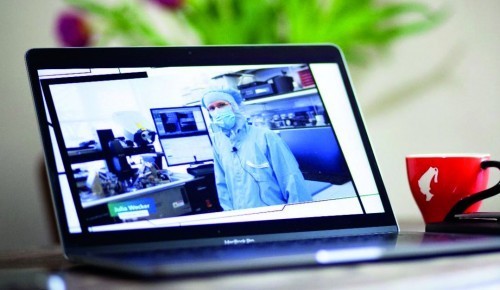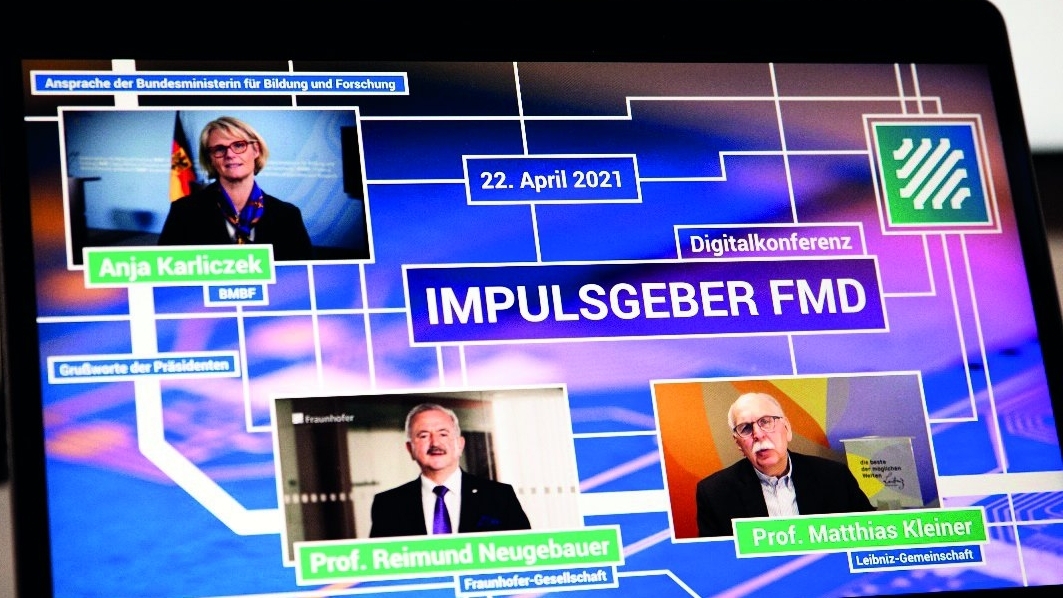The Research Fab Microelectronics Germany (FMD) officially went into operation in April 2021. The available one-stop-shop offering was presented at a digital conference.
In April 2021, the German research network Research Fab Microelectronics Germany (FMD) officially went into operation. The available one-stop-shop service was presented at a digital conference.
The FMD is one of the world's leading research networks and offers a unique range of expertise and infrastructure for micro- and nanoelectronics applications and systems in Europe. The portfolio ranges from basic research to cross-technology overall solutions and customer-specific product developments. A total of eighteen institutes of the Fraunhofer-Gesellschaft and the Leibniz Association are now cooperating. Fields of activity include, for example, ecological and sustainable information technology or trustworthy and secure microelectronics. The objectives also include ensuring European technological sovereignty in the field of quantum computing. In all topics, the FMD focuses on the future viability of the economy, especially SMEs.
Digital conference to celebrate the official start of operations
Under the title 'Impulsgeber FMD: Angebot & Potenzial - Köpfe & Know-how', the digital conference to mark the opening of the research factory focused on political topics in the morning and technological topics in the afternoon. The numerous participants from research, industry, education and politics were given an insight into the work of the FMD. Key topics for the future were also discussed and the importance of Europe's technological sovereignty was highlighted. The digital conference was opened by Dr. Stephan Guttowski, Head of the FMD office - with a brief review of the milestones in the establishment of the institution, which began in 2017. This was followed by a speech from Federal Research Minister Anja Karliczek as well as greetings and keynote speeches. The virtual tour of the FMD institutes offered a look behind the scenes (Image source: Fraunhofer Microelectronics)
The virtual tour of the FMD institutes offered a look behind the scenes (Image source: Fraunhofer Microelectronics)
Designed as a pillar for innovation
Federal Research Minister Anja Karliczek explained: "Eyes for cars and robots, tiny implants for medical technology, artificial intelligence in industry and everyday life, mobile communication beyond 5G: these are formative developments that are coming our way and will affect all of our lives. For me, one thing is clear: we need reliable and secure solutions from Germany and Europe - without compromising our values such as data protection, freedom and the rule of law. The basis for this is electronics. And this must be trustworthy and sustainable. That is why I am delighted that the Microelectronics Research Fab is now starting regular operations in full." And she emphasized: "Germany is a country of innovation and we want to remain a country of innovation." To achieve this, we must be technologically sovereign and drive forward future technologies - including in microelectronics. Hence the new framework program and the microelectronics research factory as a pillar for innovation. 350 million was invested in the establishment of the FMD, which now offers access to cutting-edge research from a single source.
Enormous investments for the future
This was underlined by the subsequent words of welcome from Prof. Reimund Neugebauer, President of the Fraunhofer-Gesellschaft, and Prof. Matthias Kleiner, President of the Leibniz Association. "The FMD is the ideal transfer partner for quickly and purposefully transferring the latest research results into application and offering customized technology and system solutions along the entire value chain," said Neugebauer. In this way, it gives small and medium-sized companies and start-ups in particular access to high technology. "FMD is thus making an important contribution to solving the current and future challenges of microelectronics research in Germany and Europe - and to becoming the world's most efficient provider of applied research, development and innovation in the field of microelectronics and nanoelectronics." Prof. Matthias Kleiner also emphasized the great importance of this new interdisciplinary and inter-organizational cooperation and the bundling of a wide range of expertise by the FMD. He emphasized that further innovations can only be created through regular investment in high technologies: "We are very grateful to the Federal Ministry of Education and Research for funding, modernizing and expanding the research infrastructure." State-of-the-art machines must be available. The FMD is a forward-looking model. It pools resources and a wide range of expertise under one roof. The task now is to exploit these opportunities.
In his keynote speech, Prof. Albert Heuberger, Chairman of the FMD Steering Committee and Fraunhofer IIS, addressed the FMD technology offering to industry and research - based on the concept, the objectives and the milestones that have been set. The Research Fab Microelectronics now comprises 18 institutes with over 3,500 employees, of which over 2,000 are scientists. In recent years, more than 250 state-of-the-art machines have been added to the FMD's laboratories and production facilities. A total of more than 12,500m2 of clean room space is available. FMD has the world's largest pool of technologies and patents in the field of smart systems.
Opportunities and challenges for SMEs
In his keynote speech, Dr. Steffen Heinz, EDC Electronic Design, Chemnitz, as an industry representative, highlighted the opportunities and challenges for SMEs in the age of life science innovation using his company as an example. He discussed the opportunities and benefits of new technologies. For example, better healthcare can be achieved with integrated and miniaturized components and technologies for near-patient laboratory diagnostics. A corresponding technology platform for in-vitro diagnostics, i.e. rapid point-of-care multiparameter sensing for the detection and quantification of pathogens, biomarkers or tumor cells, has been developed. This is based on standard CMOS technology as well as special back-end processes for the required precious metal electrodes and photolithography processes for the realization of microfluid structures. The first application is already at the small series production stage. Thanks to such microchip diagnostics solutions (lab-on-chip), laboratory space and the consumption of chemicals can increasingly be saved - by several orders of magnitude. And in addition to the cost savings achieved by using biochemical sensors instead of laboratory equipment, diagnostics can also be improved.
Future viability in global competition
The keynote speeches were followed by a panel discussion moderated by Sven Oswald (RBB) entitled 'Impulsgeber FMD: Impulses for current and future challenges in microelectronics'. The participants were Dr. Steffen Heinz, Prof. Albert Heuberger, Prof. Ina Schieferdecker, BMBF, and Prof. Günther Tränkle, FMD and Leibniz FBH. Conclusion of the discussion: The joint commitment of research, industry and politics creates invaluable added value. State-of-the-art and forward-looking structures, such as the Research Fab Microelectronics Germany, will ensure the future viability of Germany and Europe, even in the face of difficult global competition.
The morning concluded with a virtual tour of several FMD sites. FMD employees demonstrated the technological capabilities gained through BMBF investment funding, including a new high-tech production line for III-V semiconductors with a 10 nm lithography system.
In the afternoon of the digital conference, the technological highlights of the participating institutes were presented. These included the latest technologies from the fields of sensor systems, extended CMOS, microwaves and terahertz, power electronics, MEMS actuators and optoelectronic systems, which are being combined into innovative solutions and prepared for application as part of the FMD. Dr. Stephan Guttowski concluded by highlighting the opportunities for cooperation with the FMD.


